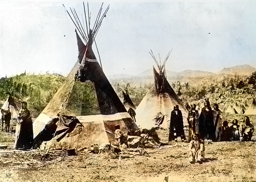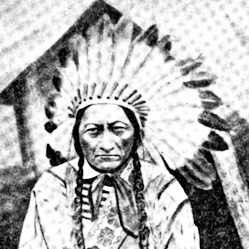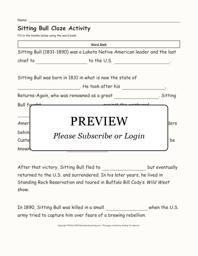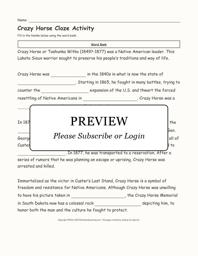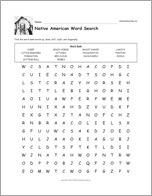Crazy Horse or Tashunka Witko (1842?-1877) was a Great Plains Native American, a Lakota Sioux warrior. He was a major leader in the Battle of the Little Bighorn, in which U.S. Gen. Custer was defeated and his entire unit killed.
Introduction
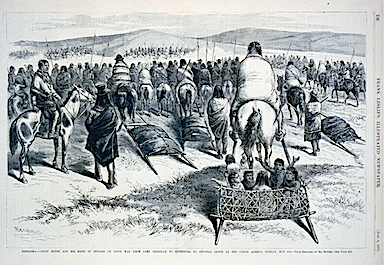
Crazy Horse on his way to surrender to Gen. Crook (1877)
Crazy Horse or Tashunka Witko (1849?-1877) was a Great Plains Native American. A Lakota Sioux warrior, he was a key figure in the American-Indian Wars. He also famously, alongside Sitting Bull, led the surge against the U.S. government in the Battle of the Little Bighorn, culminating in what is known as Custer’s Last Stand.
Throughout his life, Crazy Horse sought to preserve his people’s traditions, and he struggled against the U.S. government’s attempts to drive Native Americans into reservations. As was the custom among many Native Americans at the time, he was unwilling to have his picture in any photographs.
Early Life
Born in what is now South Dakota in the 1840s, not much is known about Crazy Horse’s early life. Even how he got the name Crazy Horse is uncertain, although it seems that he inherited it from his father. This would have been a name given after he’d proven himself in battle—which didn’t take long, as he was already a leader in small raids while still a teenager.
The American-Indian Wars
It was in 1865 that he first battled white settlers, over territory in Wyoming. This was only the first of numerous skirmishes he participated in through the 1860s and 1870s, including the 1867 attack on Fort Phil Kearney during Red Cloud’s War and the 1876 Battle of Rosebud Creek. Many of these were fought with Sitting Bull. All of these battles were attempts to counter the westward expansion of the United States and to thwart the forced resettling of Native Americans in reservations. Throughout, Crazy Horse proved to be a brave and strategically keen leader.
In 1876, Crazy Horse challenged the American government over the proclamation that all Lakota Sioux were to be moved to reservations, and he led an army of Sioux and Cheyenne warriors in resistance. Later in 1876, the Battle of the Little Bighorn saw Crazy Horse, Sitting Bull, and Chief Gall come up against Gen. George Custer and his battalions. Outnumbering Custer’s men, the Sioux and Cheyenne fighters soon divided and overwhelmed the U.S. force. In the aftermath of Custer’s Last Stand (where all of Custer’s party were killed), Crazy Horse’s ally Sitting Bull fled to Canada ahead of oncoming U.S. soldiers. Crazy Horse was less lucky and, after fighting General Nelson Miles, he was forced to surrender to the American government. In 1877, he was transported to a Native American reservation. However, after a series of rumors that he was planning an escape or uprising, Crazy Horse was arrested and killed.
Legacy
Known for his military leadership and for fighting against Native Americans being driven into reservations, Crazy Horse’s legacy is memorable. Immortalized as the victor in Custer’s Last Stand, he is a symbol of freedom and resistance for Native Americans. Symbolizing this is the Crazy Horse Memorial: a colossal rock formation in South Dakota depicting him, meant to honor both the man and the culture he fought to protect.
More on Native Americans
Totem poles are huge wooden columns which were made by Native Americans along the Pacific coast of North America. Traditionally, each totem pole tells the story of a Native American family’s ancestral spirits and family history, pictured in human and animal form.
Native Americans lived in many different types of housing. Read about tipis, grass houses, wattle-and-daub houses, pueblos, wigwams, longhouses, plank houses, and even igloos!
A printable worksheet on Pocahontas (1595?-1617), with a short biography, a picture to color, and questions to answer.
Answers: 1. Chief Powhatan, 2. John Smith, 3. Jamestown, 4. John Rolfe, 5. England.
Chief Pontiac (1720-1769) was a great leader of the Ottawa Indian tribe. He organized his and other tribes in the Great Lakes area to fight the British, in what is known as Pontiac’s War.
Sacajawea or Sacagawea (1788-1812) was a Shoshone Indian giude, interpreter, and negotiator for Lewis and Clark on their exploratory expedition to the U.S. West. She traveled with them from North Dakota to the Oregon coast and back.
Read about Sitting Bull (1831-1890), the courageous Lakota leader. He was the last Native American chief to surrender to the U.S. government.
Fill in the blanks in this printout, which is a short biography of the Native American leader Sitting Bull. He was the last chief to surrender to the U.S. government.
Word bank: battle, Canada, expansion, father, South Dakota, Stand, courageously, government, surrender, Custer, reservations, warrior.
Read about Crazy Horse or Tashunka Witko (1849?-1877), a Lakota Sioux warrior who was a leader in the Native American victory over the U.S. government in the Battle of the Little Bighorn, Custer’s Last Stand.
Fill in the blanks in this short biography of the Native American warrior Crazy Horse, who was victorious over Gen. Custer in the Battle of the Little Bighorn.
Word bank: American, army, Bighorn, born, brave, Custer, photographs, reservations, sculpture, South Dakota, surrender, westward.
These printable graphic organizer worksheets can be used to organize material for reports on Native Americans. Includes each of: Canada/Alaska, the U.S., North America, Central America, and South America. Each region has a simple graphic organizer and a more complex graphic organizer.
Find words relating to Native Americans in this wordsearch puzzle. Look up, down, left, right, and diagonally! The PDF file includes both the word-search puzzle and the answer key.
Word bank: Sitting Bull, Powhatan, Sacajawea, Red Cloud, Crazy Horse, Ottawa, Lakota, Ghost Dance, Pontiac, Tribes, Sioux, Pocahontas, Chief, Little Bighorn
Make a tepee, a totem pole, a Kachina doll, a rattle, a dream catcher, and a paper canoe! Or combine a number of these simple crafts on a Native American bulletin board for a visually exciting display.

